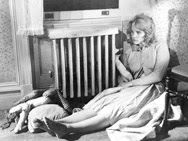My Favorite Films, Plague Edition (Volume 17): A Little-Known Gem from the 1960’s Art Scene
Something Wild (1961)
Directed by Jack Gerfein
Starring Carroll Baker and Ralph Meeker
So what to make of Something Wild, a poorly named, outstanding film from 1961. This is not the entertaining 1986 comedy film with the bland Jeff Daniels led into perdition by the tempting NYC wild girl Melanie Griffith. The harrowing 1961 version was made by Jack Garfein, a key figure in the NYC Actor’s Studio. This was the influential acting school of the 1950's-60's that pretty much invented method acting, where inner emotions were to be channeled by absolute immersion in the character you played. This led some actors to, say, spend six months as a short-order cook before playing that role in a film or in the theater. One of the founders of the Actor’s studio was Elia Kazan, director of excellent 1950’s films like On the Waterfront (labor strife), A Gentleman’s Agreement (antisemitism), and A Streetcar Named Desire. One of his colleagues was Jack Gerfein (1930-2019), a NYC acting teacher who coached actors like Marlon Brado, James Dean, Steve McQueen, and Ben Gazzara. As a teen, Gerfein survived 11 concentration camps during WWII, and his entire family was killed there. When he settled in NYC and affiliated with the Actor’s Studio, he largely stayed in the background as a coach, but eventually directed off-Broadway. He made two films, the censored The Strange One (1957) about racial inequality (but banned for “homosexual overtones”) and this one, Something Wild, a brutally honest and disturbing work about the effects of sexual assault on a young woman.
The film gets right going, with the perky, Doris Day type Mary Ann Robinson (what a great 1950's name) getting off the subway and being brutally raped in a city park within the first five minutes. The rape is suggested more than shown but is shockingly portrayed, amplified by a striking modernist movie score by Aaron Copland. How did this film even get released in 1961? Like the good daughter she is, Mary Ann buttons herself up, tells no one, and goes home to her parents as if nothing happened. There is an unbelievably harrowing scene as she is forced to rub up against men in an overcrowded subway car just after the rape. But this rape turns around her life. She drops college, shuns human contact, moves into a dank, tiny NY studio basement apartment, and goes to work for Woolworth as a cashier, all the while retreating into herself. Mary Ann is played by the director’s wife Carroll Baker, an Actor’s Studio disciple who was to star in several 1960s films like Giant (with James Dean), How the West was Won, and The Carpetbaggers. Here, she is astonishing. She plays the buttoned down, repressed, wounded young woman brilliantly, only rarely letting loose from the buried emotions and scars, yet always displaying them subtly in her gestures and interactions with others. When she is taken in by a lonely man (also who lives in another tiny NYC studio in a basement), she only very gradually won over by him, perhaps because is a damaged alcoholic with his own problems. In a prequel to Boxing Helena, he keeps her locked in his apartment because he “likes his life better when she is around”, but when she finally escapes, she returns to him, and eventually marries him. None of this is done with typical 1950's melodrama or Hollywood hype, and is much more reminiscent of how Bergman directed his actors during the same period, in Europe. Everything is about genuine portrayal, as if we are peeking into their environment as voyeurs. Mary Ann is a magnificently complex character, repressed, angry, sympathetic, and repellent in turns. What a role. This should be a textbook viewing for students studying PTSD.


Comments
Post a Comment